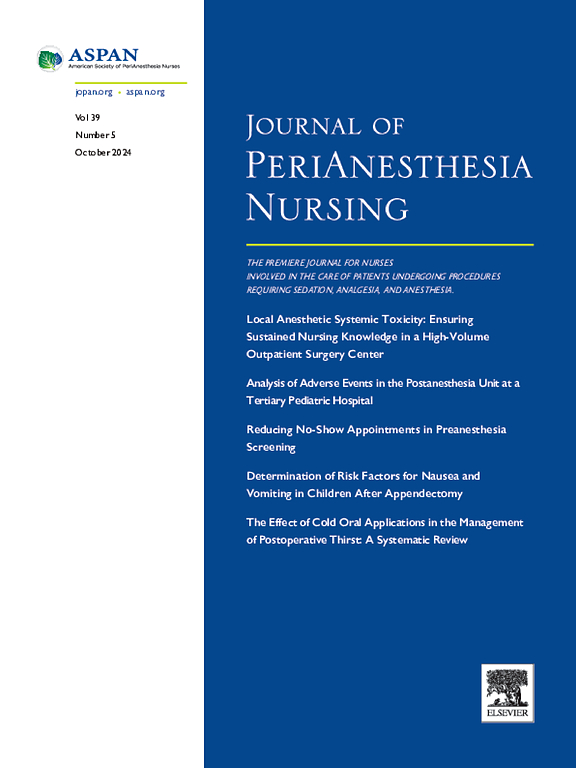围手术期工作人员对儿童用药的经验。
IF 1.6
4区 医学
Q2 NURSING
引用次数: 0
摘要
目的:为表现出焦虑或与焦虑相关的负面反应的儿童提供围手术期护理是一项挑战。使用术前用药被认为是手术前对幼儿的一项重要干预措施,但对护理人员术前用药经验的研究却很有限。本研究旨在探讨围手术期工作人员为学龄前儿童进行术前用药的经验:设计:在焦点小组讨论的基础上进行描述性归纳定性研究:方法:以小组为单位,有目的性地抽取手术部门中具有围术期儿童麻醉和护理经验的团队成员进行访谈,其中包括五名术前和术后护理护士、五名麻醉师护士和五名麻醉师。采用定性内容分析法对转录文本进行了分类:内容分析揭示了三个主题:时间问题、不要吵醒沉睡的熊和踮起脚尖:护理人员必须根据患儿的情绪状态和需求调整工作,留出时间让患儿信任和接受术前用药,并让术前用药达到最佳效果。术前用药可提供轻度睡眠,这就需要谨慎对待患儿以避免情绪反应,而当术前用药支持较长时间的镇静时,术后的道路是最平静的。我们的研究结果凸显了安全预防措施和灵活放任的组织方式的必要性,其目的是让患儿在围手术期能够顺利安全地完成手术。本文章由计算机程序翻译,如有差异,请以英文原文为准。
Perioperative Staff’s Experiences of Premedication for Children
Purpose
Providing perioperative care for children who express anxiety or react with negative anxiety-associated consequences can be a challenge. The use of premedication is established as an important intervention for young children before surgery, yet research into care providers’ experiences of premedication is limited. The aim of this study was to explore perioperative staff’s experiences of premedication for preschool-age children.
Design
A descriptive inductive qualitative study was performed based on focus group discussions.
Methods
A purposive sample of a team from the operating department with experience in anesthetizing and caring for children in the perioperative period was interviewed in small focus groups: five preoperative and postoperative care nurses, five nurse anesthetists, and five anesthesiologists. The transcribed text was categorized using qualitative content analysis.
Findings
The content analysis revealed three themes: a matter of time, do not wake the sleeping bear, and on responsive tiptoes.
Conclusions
Care providers must adapt their work to the child’s emotional state of mind and needs, allowing time for the child to trust and accept the premedication and for the premedication to reach its peak effect. Premedication provides light sleep preoperatively, which requires careful treatment of the child to avoid emotional reactions, and the postoperative path is most peaceful when the premedication supports a long duration of sedation. Our findings highlight the need for safety precautions and a permissive and flexible organization with the goal of achieving a smooth and safe journey for the child in the perioperative path.
求助全文
通过发布文献求助,成功后即可免费获取论文全文。
去求助
来源期刊

Journal of Perianesthesia Nursing
NURSING-
CiteScore
2.20
自引率
17.60%
发文量
279
审稿时长
90 days
期刊介绍:
The Journal of PeriAnesthesia Nursing provides original, peer-reviewed research for a primary audience that includes nurses in perianesthesia settings, including ambulatory surgery, preadmission testing, postanesthesia care (Phases I and II), extended observation, and pain management. The Journal provides a forum for sharing professional knowledge and experience relating to management, ethics, legislation, research, and other aspects of perianesthesia nursing.
 求助内容:
求助内容: 应助结果提醒方式:
应助结果提醒方式:


